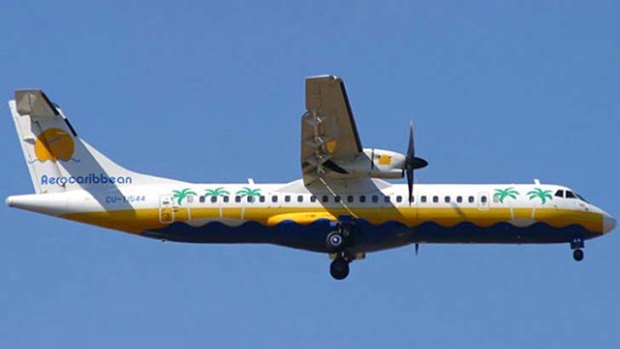
An ATR-72-212 twin turboprop aircraft flown by Cuban Aero Caribbean. Higher fuel costs are making turboprop aircraft a more attractive option for airlines.Credit: Reuters
Rising fuel prices and a more environmentally conscious society are expected to increase demand for turboprop aircraft in the years ahead, an aircraft manufacturer says.
Head of sales at turboprop aircraft maker ATR, John Moore, says there is "no contest" between its 50-seat and 70-seat planes and a similarly sized regional jet in terms of fuel burn.
As jet fuel prices show little sign of dropping, Mr Moore says the benefits of the turboprop will become more obvious only as airlines strive to constrain costs in the face of greater competition from low-cost carriers.
"The turboprop, and ATR, has had renewed success over the last few years, partly as a virtue of the increase in fuel prices," Mr Moore said on the sidelines of the Avalon Airshow.
"Because the turboprop has a much more efficient engine, it burns a lot less fuel than a jet and airlines have really been rediscovering the benefits of a turboprop.
"Our sales have really taken off over the last few years."
Mr Moore said ATR had sold about 350 aircraft during the past five years, with half the sales in the Asia Pacific region in places such as Indonesia, New Zealand, Malaysia, and Papua New Guinea.
Until last month, ATR's presence in Australia had been limited to mining flights in Queensland and as a freight aircraft for a logistics operator.
That changes from the middle of 2011 when Virgin Blue takes delivery of the first of up to 18 ATR 72 aircraft as part of its partnership with Skywest to fly on regional routes.
Mr Moore said having ATR aircraft in Australian skies and exposing the product to the travelling public would help improve sales here.
"Once the product becomes better known, our company becomes better known and we build up the infrastructure that we need to support the operators.
"We're very hopeful that will produce other opportunities, as well.
"Turboprops tend to have an image of being less modern or less comfortable, so we've really made a lot of effort to make it a very comfortable aircraft in terms of noise, vibration and cabin amenities such as overhead bins."
Mr Moore also saw opportunities in the US, as carriers dump regional jets in favour of the turboprops.
"The US went even further into jets than anybody else and now, of course, they are suffering the consequences of it," Mr Moore said.
"It is going to take some time for those jets to be worked out of the system, so I think there is will be a lot more turboprops there in the US."
While the largest sized turboprops currently on the market are for 70 seats, Mr Moore said there has been talk of something bigger, perhaps in the 100-seat category.
Any decision on whether to build a bigger turboprop aircraft would depend on engine manufacturers and the level of interest shown by the airlines, he said.
"We believe there is a market in that size category."
ATR, based in Toulouse, France, is a joint-venture between Airbus maker EADS and Italy's Alenia Aeronautica.
AAP
Sign up for the Traveller newsletter
The latest travel news, tips and inspiration delivered to your inbox. Sign up now.